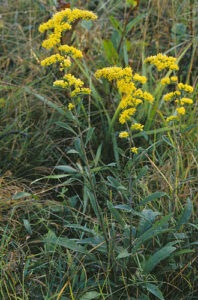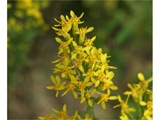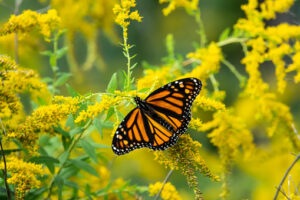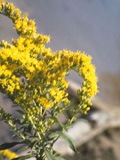
by CMG Betty J
A sure sign of fall in the Hill Country is the appearance of the bright yellow flowers atop the stems of Prairie Goldenrod, Solidago nemoralis, sometimes called Old Field Goldenrod. These common perennial flowers grow along roadsides, in ditches and in upland prairies. Their sturdy stems are about two feet tall, making them one of the smaller Solidago species. Goldenrods are native to North America, including Mexico and a few species live in South America and Eurasia. The species are very similar, making it difficult to distinguish one from another. The small stature and tidy growth habit of Prairie Goldenrod makes is a nice addition to a flower garden. Gay Feather and Autumn Sage look particularly nice when paired with it.

The compound goldenrod flowers are yellow and tend to be crowded onto one side of the curved stems. The individual blossoms resemble small daisies. Minute hairs cover the stems and leaves but they are fine enough that the foliage seems smooth to a touch. The leaves are 1-3” long and usually not toothed or serrated.

Natural propagation occurs by wind-disseminated seeds or underground rhizomes. The rhizomes form a colony of actual clones of the original plant. September and October are the prime bloom months for goldenrod. When the weather is warm and sunny they produce a good supply of nectar and are a favorite food source for butterflies, wasps and bees. The pollen from goldenrods is often blamed for hay fever allergies. However, goldenrod pollen is too heavy and sticky to be blown by the wind. Ragweed, Ambrosia, is the actual culprit since it blooms at the same time as the goldenrod and is responsible for most of the allergic reactions.

Goldenrod leaves contain rubber! According to Wikipedia, Thomas Edison experimented with making rubber from goldenrod plants. He produced a 12-foot tall plant that yielded 12% rubber by volume. Henry Ford embraced the idea of goldenrod rubber and when he gave a car to Edison it was outfitted with tires made of goldenrod rubber. Extensive experimentation to find an economically viable alternative rubber began in earnest during World War II. However, the resulting goldenrod rubber was of low molecular weight and the sticky compound had such a poor tensile strength that it was not a good tree rubber substitute.